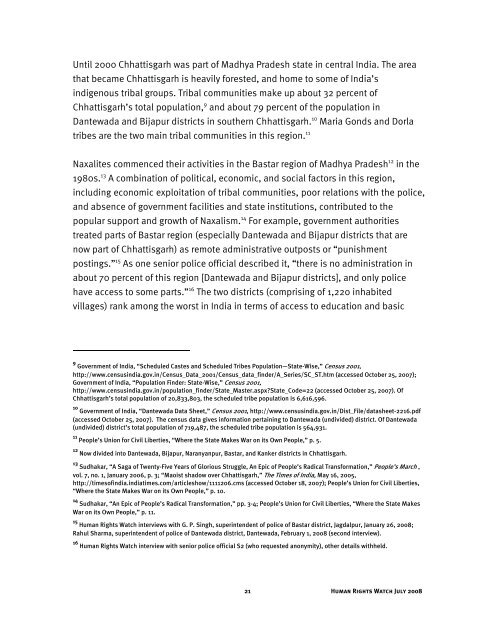âBeing Neutral is Our Biggest Crimeâ - Global Coalition to Protect ...
âBeing Neutral is Our Biggest Crimeâ - Global Coalition to Protect ...
âBeing Neutral is Our Biggest Crimeâ - Global Coalition to Protect ...
You also want an ePaper? Increase the reach of your titles
YUMPU automatically turns print PDFs into web optimized ePapers that Google loves.
Until 2000 Chhatt<strong>is</strong>garh was part of Madhya Pradesh state in central India. The area<br />
that became Chhatt<strong>is</strong>garh <strong>is</strong> heavily forested, and home <strong>to</strong> some of India’s<br />
indigenous tribal groups. Tribal communities make up about 32 percent of<br />
Chhatt<strong>is</strong>garh’s <strong>to</strong>tal population, 9 and about 79 percent of the population in<br />
Dantewada and Bijapur d<strong>is</strong>tricts in southern Chhatt<strong>is</strong>garh. 10 Maria Gonds and Dorla<br />
tribes are the two main tribal communities in th<strong>is</strong> region. 11<br />
Naxalites commenced their activities in the Bastar region of Madhya Pradesh 12 in the<br />
1980s. 13 A combination of political, economic, and social fac<strong>to</strong>rs in th<strong>is</strong> region,<br />
including economic exploitation of tribal communities, poor relations with the police,<br />
and absence of government facilities and state institutions, contributed <strong>to</strong> the<br />
popular support and growth of Naxal<strong>is</strong>m. 14 For example, government authorities<br />
treated parts of Bastar region (especially Dantewada and Bijapur d<strong>is</strong>tricts that are<br />
now part of Chhatt<strong>is</strong>garh) as remote admin<strong>is</strong>trative outposts or “pun<strong>is</strong>hment<br />
postings.” 15 As one senior police official described it, “there <strong>is</strong> no admin<strong>is</strong>tration in<br />
about 70 percent of th<strong>is</strong> region [Dantewada and Bijapur d<strong>is</strong>tricts], and only police<br />
have access <strong>to</strong> some parts.” 16 The two d<strong>is</strong>tricts (compr<strong>is</strong>ing of 1,220 inhabited<br />
villages) rank among the worst in India in terms of access <strong>to</strong> education and basic<br />
9 Government of India, “Scheduled Castes and Scheduled Tribes Population—State-W<strong>is</strong>e,” Census 2001,<br />
http://www.censusindia.gov.in/Census_Data_2001/Census_data_finder/A_Series/SC_ST.htm (accessed Oc<strong>to</strong>ber 25, 2007);<br />
Government of India, “Population Finder: State-W<strong>is</strong>e,” Census 2001,<br />
http://www.censusindia.gov.in/population_finder/State_Master.aspx?State_Code=22 (accessed Oc<strong>to</strong>ber 25, 2007). Of<br />
Chhatt<strong>is</strong>garh’s <strong>to</strong>tal population of 20,833,803, the scheduled tribe population <strong>is</strong> 6,616,596.<br />
10 Government of India, “Dantewada Data Sheet,” Census 2001, http://www.censusindia.gov.in/D<strong>is</strong>t_File/datasheet-2216.pdf<br />
(accessed Oc<strong>to</strong>ber 25, 2007). The census data gives information pertaining <strong>to</strong> Dantewada (undivided) d<strong>is</strong>trict. Of Dantewada<br />
(undivided) d<strong>is</strong>trict’s <strong>to</strong>tal population of 719,487, the scheduled tribe population <strong>is</strong> 564,931.<br />
11 People’s Union for Civil Liberties, “Where the State Makes War on its Own People,” p. 5.<br />
12 Now divided in<strong>to</strong> Dantewada, Bijapur, Naranyanpur, Bastar, and Kanker d<strong>is</strong>tricts in Chhatt<strong>is</strong>garh.<br />
13 Sudhakar, “A Saga of Twenty-Five Years of Glorious Struggle, An Epic of People’s Radical Transformation,” People’s March ,<br />
vol. 7, no. 1, January 2006, p. 3; “Mao<strong>is</strong>t shadow over Chhatt<strong>is</strong>garh,” The Times of India, May 16, 2005,<br />
http://timesofindia.indiatimes.com/articleshow/1111206.cms (accessed Oc<strong>to</strong>ber 18, 2007); People’s Union for Civil Liberties,<br />
“Where the State Makes War on its Own People,” p. 10.<br />
14 Sudhakar, “An Epic of People’s Radical Transformation,” pp. 3-4; People’s Union for Civil Liberties, “Where the State Makes<br />
War on its Own People,” p. 11.<br />
15 Human Rights Watch interviews with G. P. Singh, superintendent of police of Bastar d<strong>is</strong>trict, Jagdalpur, January 26, 2008;<br />
Rahul Sharma, superintendent of police of Dantewada d<strong>is</strong>trict, Dantewada, February 1, 2008 (second interview).<br />
16 Human Rights Watch interview with senior police official S2 (who requested anonymity), other details withheld.<br />
21<br />
Human Rights Watch July 2008
















